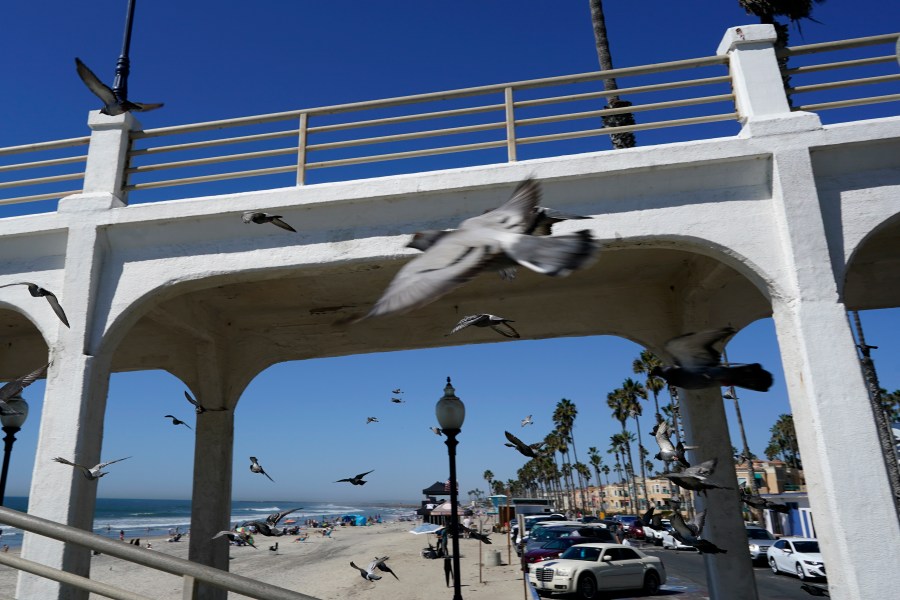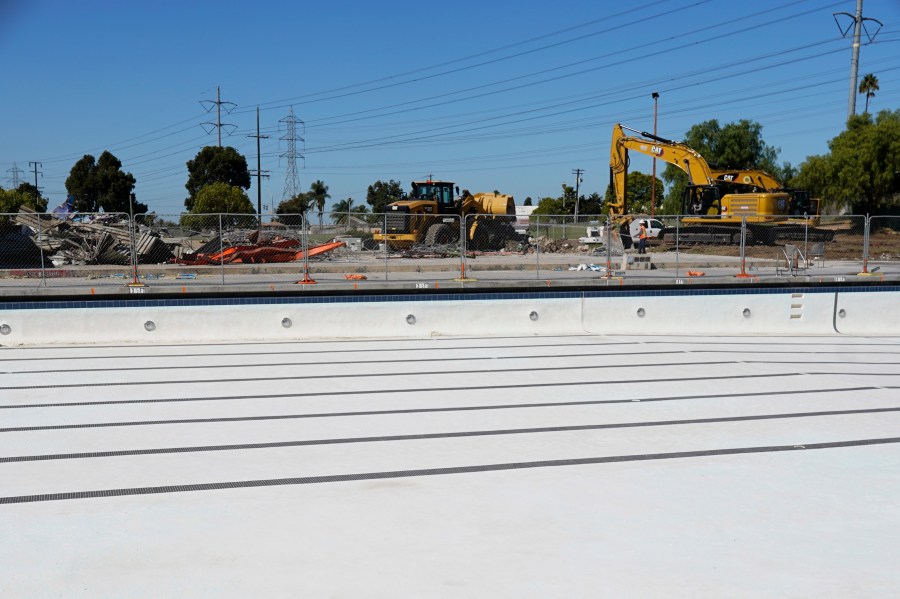(AP)— At the Loma Verde Recreation Center south of San Diego, demolition work is underway on a $24 million project that will rebuild the facility from the ground up, complete with a new pool. An hour’s drive to the north, the iconic bridge to the Oceanside pier is deteriorating because the city lacks the money for a roughly $25 million rehabilitation.
A reason one project is moving ahead and the other isn’t revolves around the American Rescue Plan — the sweeping COVID-19 relief law championed by President Joe Biden and congressional Democrats that is pumping billions of dollars to states and local governments.
Under rules developed by the U.S. Treasury Department, some governments have more flexibility than others to spend their share of the money as they want. That’s why the new swimming pool is a go, and the rehabbed pier — at least for now — is a no.
Similar disparities among cities across the country have prompted a pushback from local officials, who want Treasury to loosen its rules before the program progresses much further.
“Otherwise, they are penalizing cities for the pandemic, not providing them relief,” said Wade Kapszukiewicz, the mayor of Toledo, Ohio.

At issue is $350 billion for states, counties and cities that was part of the massive COVID-19 relief bill Biden signed in March. The money is intended to help shore up their finances, pay the ongoing costs of fighting the virus and invest in longer-term projects that could strengthen communities for years to come. The funding was made available by the Treasury beginning in May — though states and cities have been slow to start spending it.
The Treasury’s guidelines give governments leeway to choose from more than 60 subcategories for spending the money, including COVID-19 vaccinations, premium pay for certain workers, housing aid, grants to businesses and improvements to water, sewer and internet infrastructure.
But one particular category stands out for its flexibility. Governments that lost revenue can use their federal aid for almost any services, up to the amount of their losses. That means they can spend the money on roads, a recreation center or a pier, which might not otherwise be eligible.
Treasury spokesperson Liz Bourgeois said the plan gives governments “the resources and flexibility they need to avoid cuts, hire or retain workers, provide essential services, and come out of the pandemic stronger.” Democratic congressional leaders also have praised the Treasury’s flexible guidance.
But some local officials think the Treasury’s formula for calculating lost revenue is too restrictive. It rolls most revenue sources together instead of calculating losses on a fund-by-fund basis, which would let governments claim losses in dedicated funds such as gas taxes for roads even if other revenue grew. Local governments also want to exclude recently enacted tax hikes from the calculation, which they contend masks the depth of their losses during the pandemic.

In Toledo, voters last November approved a temporary one-quarter percent income tax increase that is projected to raise $19 million annually for roads. As a result, that revenue will offset other losses under the Treasury’s calculation, meaning the city won’t have the flexibility to use relief money to replace old police vehicles, Kapszukiewicz said.
“It now falsely looks like our economy has recovered more than it has, when in reality, it merely reflects the revenue produced by putting an extra burden on ourselves,” the mayor said. “It’s absurd.”
In California, more than 250 cities and counties enacted voter-approved tax increases since 2018 — most coming during or after the 2018-19 fiscal year that forms the basis for calculating revenue loss, according to an analysis conducted for The Associated Press by government finance consultant Michael Coleman.
The southern San Diego suburb of Chula Vista, which did not enact new taxes, calculated revenue losses of more than $32 million under the Treasury’s guidelines — covering over half its $57.5 million allotment under the American Rescue Plan. Among other things, the city is directing $12.2 million for culvert repairs at two intersections to alleviate flooding and $8 million to add new aquatic facilities to a planned renovation of the Loma Verde Recreation Center. Had the city not been able to tap the revenue-loss category for federal funding, those projects could have been pushed off indefinitely, said Chula Vista city engineer William Valle.
By doing it all at once “it’s open to the community — boom, everybody’s happy,” Valle said.

In Oceanside, however, officials have less latitude over their federal aid. Voters there approved a one-half cent sales tax that took effect in April 2019, reducing its revenue loss under the Treasury formula from $22 million to $12 million and limiting its spending flexibility. Further complicating matters, the city spent nearly $2.6 million from its reserves — which otherwise could have gone toward infrastructure — to provide meals, homeless services and business grants during the pandemic. But the Treasury’s rules prohibit the federal aid from being used to replenish reserves.
Oceanside officials would like to be able to direct more of their federal money toward fixing the seismically unsafe 1920s-era bridge that leads to its pier.
“It’s imperative that the pier be maintained and restored so that it continues to attract visitors,” said Rick Wright, CEO of MainStreet Oceanside, the downtown business association. He added: “I don’t think it’s immediately noticeable to people that it’s in grave need of restoration, but if you look close enough, you can see where there’s cracks and pieces that have fallen out already.”
Other cities also have written to the Treasury asking it to loosen its revenue-loss rule and give them greater say over the money. It’s a reasonable request, but the dispute highlights that local governments are receiving “dramatically more money” than needed, said Marc Goldwein, senior vice president of the nonprofit Committee for a Responsible Federal Budget.
Treasury officials said they are considering the comments but have given no indication of whether they will change the rule, nor when the final version will be released.
In the meantime, Des Moines, Iowa, is holding off on making spending decisions for the $47 million it received. The city wants clarification on whether it can count $34 million of losses not currently allowed under the Treasury rule, which would give it far more flexibility, said deputy finance director Joe Brandstatter.

In Lincoln, Nebraska, plans for a new parking garage have been delayed because of the Treasury’s revenue-loss rule. Parking revenue plunged during the pandemic, said mayoral aide Kate Bolz, but the city can’t make up for it all because a new sales tax earmarked for streets reduced its 2020 revenue loss from $13.5 million to $2.4 million under the Treasury’s formula.
Flagstaff, Arizona, also has put plans for a downtown parking garage on hold because of the Treasury rule and may have to delay replacing its aging snow plows, street sweepers and trucks. New revenue from a combination of dedicated taxes and storm-water fees offset the city’s loss under the Treasury’s formula, taking away its flexibility for the federal aid.
“The intent of what Congress wanted to do is to help support cities who had these big dollar losses to continue providing the services,” said city treasurer Rick Tadder. But the Treasury’s rule “is restrictive on how cities can demonstrate the true impact on our revenues during this pandemic.”

